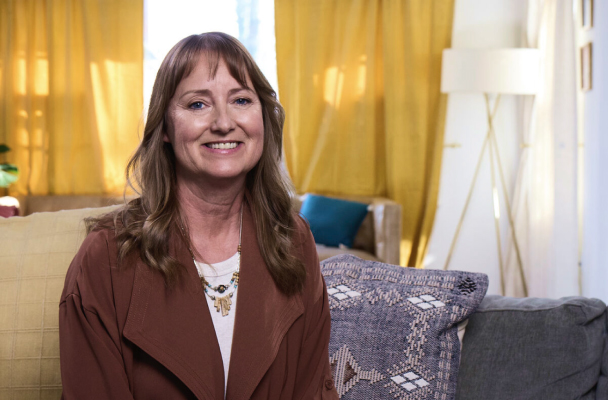[VENCLEXTA LOGO]
VENCLEXTA is a prescription medicine used to treat adults with chronic lymphocytic leukemia (CLL) or small lymphocytic lymphoma (SLL). It is not known if VENCLEXTA is safe and effective in children.
Please see Important Safety Information throughout this video.
Please see full Prescribing Information, including Medication Guide, on www.VENCLEXTA.com or at www.rxabbvie.com/pdf/venclexta.pdf
SHELLY: I am Shelly, and I was diagnosed with CLL. I was treated with VENCLEXTA in August 2018, and completed the treatment in July 2019.
[TEXT ON SCREEN]
SHELLY
Completed VENCLEXTA
in 2019
[TEXT ON SCREEN]
TIME-OFF TALKS
ROBIN: I was diagnosed with CLL, and I am watch and wait, currently, thankfully, and hopefully for years to come.
[TEXT ON SCREEN]
ROBIN
Diagnosed 2023
Waiting for first treatment
ROBIN: Tell me about when you started taking VENCLEXTA. How does that all work?
SHELLY: After I was done with the infusion portion of it, which was obinutuzumab, then they start with the VENCLEXTA pills.
SHELLY: It’s a ramp-up process.
[TEXT ON SCREEN]
GAZYVA® (obinutuzumab), an antibody infusion therapy, is started first and is given during the first 6 cycles of treatment. VENCLEXTA is a pill that’s taken once a day with a meal and water. In week 4, your doctor will start VENCLEXTA at a low dose and then slowly increase the dose over the following 5 weeks up to the full dose.
SHELLY: But between everything, they do blood tests. And each test shows you where your blood counts are at.
[TEXT ON SCREEN]
It is important to drink plenty of water when taking VENCLEXTA. You will receive other medicines before starting and during treatment. Take VENCLEXTA exactly as prescribed. Do not start taking VENCLEXTA until you have reviewed the specific instructions with your doctor. You may be directed to take your first dose and any increase in your dose in your doctor’s office or at the hospital.
SHELLY: I completed VENCLEXTA in about a year. Every test I’ve done has come back that my white count is good. For now, I’m not progressing.
[TEXT ON SCREEN]
VENCLEXTA + GAZYVA IS DESIGNED TO BE COMPLETED
IN 12 MONTHS FOR PREVIOUSLY UNTREATED CLL/SLL
In a clinical trial with a 28-month median follow-up, 13% of patients on VENCLEXTA + GAZYVA had disease progression or died vs 37% of patients on chemoimmunotherapy. More than half were progression-free and treatment-free after 5 years.
SHELLY: And I’m off treatment.
ROBIN: Did they prepare you for any side effects?
SHELLY: They did talk about tumor lysis being a serious one that can happen at the beginning of the treatment. Because that’s more of your system dumping the cancer at a very rapid rate.
[TEXT ON SCREEN]
VENCLEXTA can cause serious side effects, including tumor lysis syndrome, low white blood cell counts, and infections. These are not all of the possible side effects of VENCLEXTA. Talk to your healthcare provider for more information about the risks and side effects of VENCLEXTA.
SHELLY: And they have to keep an eye on it—that it doesn’t dump everything all at once, but that it does it at a more gradual process. And they watch it very closely.
[TEXT ON SCREEN]
The most common side effects of VENCLEXTA + GAZYVA include low white blood cell counts, low red blood cell counts, diarrhea, nausea, upper respiratory tract infections, and tiredness.
ROBIN: Can you tell me about some of the fears you faced, and maybe some advice that you would have looking back?
SHELLY: Fears that I faced were not knowing exactly as it went along what was going to come up. Cancer is a big word—it’s in your head and it’s in there all the time, 24/7.
SHELLY: If I had advice to anybody, it would be that you tell your family and friends because they do want to know. They do want to be there to support you.
ROBIN: So what have you learned on this CLL journey?
SHELLY: It taught me that you live life. You enjoy it. You live it for today.
SHELLY: It’s a good feeling, to not have CLL treatment be an everyday thing.
[TEXT ON SCREEN]
VENCLEXTA is not a cure. Individual results may vary. You will need to continue to work with your healthcare team.
SHELLY: I am really just not focusing on it anymore. I started living my life.
[TEXT ON SCREEN]
IMPORTANT SAFETY INFORMATION
[VENCLEXTA LOGO]
Important Safety Information
What is the most important information I should know about VENCLEXTA?
VENCLEXTA can cause serious side effects, including:
Tumor lysis syndrome (TLS). TLS is caused by the fast breakdown of cancer cells. TLS can cause kidney failure, the need for dialysis treatment, and may lead to death. Your healthcare provider will do tests to check your risk of getting TLS before you start taking VENCLEXTA. You will receive other medicines before starting and during treatment with VENCLEXTA to help reduce your risk of TLS. You may also need to receive intravenous (IV) fluids into your vein. Your healthcare provider will do blood tests to check for TLS when you first start treatment and during treatment with VENCLEXTA. It is important to keep your appointments for blood tests. Tell your healthcare provider right away if you have any symptoms of TLS during treatment with VENCLEXTA, including fever, chills, nausea, vomiting, confusion, shortness of breath, seizures, irregular heartbeat, dark or cloudy urine, unusual tiredness, or muscle or joint pain.
Drink plenty of water during treatment with VENCLEXTA to help reduce your risk of getting TLS. Drink 6 to 8 glasses (about 56 ounces total) of water each day, starting 2 days before your first dose, on the day of your first dose of VENCLEXTA, and each time your dose is increased.
Your healthcare provider may delay, decrease your dose, or stop treatment with VENCLEXTA if you have side effects. When restarting VENCLEXTA after stopping for 1 week or longer, your healthcare provider may again check for your risk of TLS and change your dose.
Who should not take VENCLEXTA?
Certain medicines must not be taken when you first start taking VENCLEXTA and while your dose is being slowly increased because of the risk of increased TLS.
Tell your healthcare provider about all the medicines you take, including prescription and over-the-counter medicines, vitamins, and herbal supplements. VENCLEXTA and other medicines may affect each other causing serious side effects.
Do not start new medicines during treatment with VENCLEXTA without first talking with your healthcare provider.
Before taking VENCLEXTA, tell your healthcare provider about all of your medical conditions, including if you:
have kidney or liver problems.
have problems with your body salts or electrolytes, such as potassium, phosphorus, or calcium.
have a history of high uric acid levels in your blood or gout.
are scheduled to receive a vaccine. You should not receive a “live vaccine” before, during, or after treatment with VENCLEXTA, until your healthcare provider tells you it is okay. If you are not sure about the type of immunization or vaccine, ask your healthcare provider. These vaccines may not be safe or may not work as well during treatment with VENCLEXTA.
are pregnant or plan to become pregnant. VENCLEXTA may harm your unborn baby. If you are able to become pregnant, your healthcare provider should do a pregnancy test before you start treatment with VENCLEXTA, and you should use effective birth control during treatment and for 30 days after the last dose of VENCLEXTA. If you become pregnant or think you are pregnant, tell your healthcare provider right away.
are breastfeeding or plan to breastfeed. It is not known if VENCLEXTA passes into your breast milk. Do not breastfeed during treatment with VENCLEXTA and for 1 week after the last dose.
What should I avoid while taking VENCLEXTA?
You should not drink grapefruit juice or eat grapefruit, Seville oranges (often used in marmalades), or starfruit while you are taking VENCLEXTA. These products may increase the amount of VENCLEXTA in your blood.
What are the possible side effects of VENCLEXTA?
VENCLEXTA can cause serious side effects, including:
Low white blood cell counts (neutropenia). Low white blood cell counts are common with VENCLEXTA, but can also be severe. Your healthcare provider will do blood tests to check your blood counts during treatment with VENCLEXTA and may pause dosing.
Infections. Death and serious infections such as pneumonia and blood infection (sepsis) have happened during treatment with VENCLEXTA. Your healthcare provider will closely monitor and treat you right away if you have a fever or any signs of infection during treatment with VENCLEXTA.
Tell your healthcare provider right away if you have a fever or any signs of an infection during treatment with VENCLEXTA.
The most common side effects of VENCLEXTA when used in combination with obinutuzumab or rituximab or alone in people with CLL or SLL include low white blood cell counts; low platelet counts; low red blood cell counts; diarrhea; nausea; upper respiratory tract infection; cough; muscle and joint pain; tiredness; and swelling of your arms, legs, hands, and feet.
VENCLEXTA may cause fertility problems in males. This may affect your ability to father a child. Talk to your healthcare provider if you have concerns about fertility.
These are not all the possible side effects of VENCLEXTA. For more information, ask your healthcare provider or pharmacist.
You are encouraged to report side effects of prescription drugs to the FDA. Visit www.fda.gov/medwatch or call 1-800-FDA-1088.
If you cannot afford your medication, contact genentech-access.com/patient/brands/venclexta for assistance.
Please see full Prescribing Information, including Medication Guide, on www.VENCLEXTA.com or at www.rxabbvie.com/pdf/venclexta.pdf
US-VENC-240057
[TEXT ON SCREEN]
VENCLEXTA + GAZYVA is designed to be completed in 12 months.
Ask your doctor if it’s right for you.
[VENCLEXTA LOGO]




